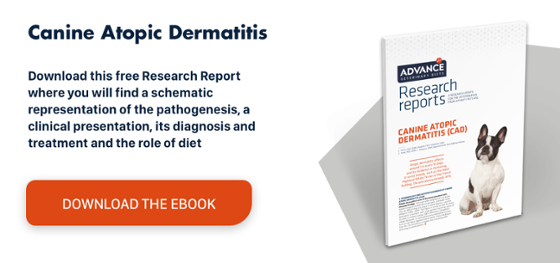Risks associated with bee stings in dogs
Bee stings in dogs can cause a severe, sometimes even fatal, anaphylactic reaction.
Introduction
Bees belong to the insect order Hymenoptera, superfamily Apoidea, which includes about 20,000 different species. Unlike other stinging insects, such as wasps or hornets, bees can only sting once, and die soon after doing so. Bees (except Africanised bees) are not aggressive and most bee stings on dogs are accidental.1 Although most cases are not serious, it is important to note that in certain situations bee stings can be fatal in dogs. This may be due to an anaphylactic reaction, a severe local reaction affecting the airway or large-scale poisoning following a swarm attack.
Toxicokinetics of bee venom
Bee venom is a complex mixture of proteins, enzymes and amines. The main component is melittin, which causes localised pain after the sting and acts as a detergent, breaking down the cell membrane and triggering the release of vasoactive amines. Together with phospholipase A2, which is the most important allergenic component in the venom, melittin can produce intravascular haemolysis. The action of these compounds has also been associated with the development of acute kidney injury (AKI), myocardial ischaemia and arrhythmias. Other components of bee venom include peptide 401 (mast cell degranulating peptide); hyaluronidase (spreading factor), which alters cell permeability, helping other venom components permeate into tissues; and vasoactive amines, such as histamine, apamin (a neuortoxin), dopamine and noradrenaline.1-3
Clinical picture
Bee stings in dogs can trigger four different reactions.
- The first occurs in all stings and consists of localised inflammation and pain that is mainly due to the vasoactive components in the venom rather than an allergic mechanism.
- The second is a slightly more severe, allergic-type reaction affecting areas adjacent to the bite.
- This may be followed by an anaphylactic reaction (type I hypersensitivity), which occurs within minutes of the sting and is characterised by varying degrees of urticaria, angioedema, nausea, vomiting, hypotension and dyspnoea.
- The fourth is the appearance of a rash 3–15 days after the sting due to a type III hypersensitivity reaction.1-2
A delayed toxic reaction has also been described in humans, occurring within 24 hours of the sting and characterised by haemolysis, thrombocytopaenia, liver disease and disseminated intravascular coagulation (DIC).2
Patients with multiple bee stings
Dogs that suffer a swarm attack and receive multiple bee stings may present with fever, lethargy, facial paralysis, ataxia and other neurological signs, as well as bloody or dark brown faeces, urine and vomit. Laboratory findings may include leukocytosis, immune-mediated thrombocytopaenia, immune-mediated haemolytic anaemia and signs of AKI.1,2,4,5 Although considered very rare, DIC and haemoabdomen following a bee stings in dogs have also been reported.6
Bee stings in dogs: treatment
Many reactions to bee stings in dogs resolve without treatment within a few hours. In any case, the application of local cold treatment may help control inflammation and reduce the patient’s discomfort. Despite the apparent mildness of the clinical picture, owners should be recommended to keep the dog under observation for 24 hours in case of any further reaction.
- If the reaction is localised, antihistamines and/or glucocorticoids should be considered.
- In patients with signs of hypotension, intravenous fluid therapy is indicated as well as monitoring of renal function for AKI.
- Finally, in cases of anaphylaxis, the patient should be administered adrenaline, fluid therapy at shock doses, antihistamines and glucocorticoids, besides maintaining a patent airway and providing oxygen therapy. Antibiotics are not indicated unless sepsis is suspected.1,2
Prevention
Insofar as possible, and especially in dogs that suffer a severe reaction, it is important to avoid future exposure to bee venom. As such, owners should be advised to avoid areas with lots of flowering plants and leaving food scraps near the dog because it may attract other hymenoptera.1 In patients with a history of anaphylaxis and who are at risk of future exposure, a course of specific bee venom immunotherapy may be considered as a means of preventing the onset of severe clinical signs in reaction to future stings.7
Conclusions
In general, bee stings do not represent a serious medical problem in dogs. However, we should never forget that in some cases bee stings can cause severe anaphylaxis or even death. Therefore, when asked about this situation or if treating a dog in the clinic with a bee sting, it is always important to act with caution and recommend that the patient is watched closely for the next 24 hours.
References
1. Fitzgerald KT, Flood AA. (2006). Hymenoptera stings. Clin Tech Small Anim Pract; 21: 194-204.
2. Buckley GJ, Corrie C, Bandt C, et al. (2017). Kidney injury in a dog following bee sting-associated anaphylaxis. Can Vet J; 58: 265-269.
3. Oliveira EC, Pedroso PM, Meirelles AE, et al. (2007). Pathological findings in dogs after multiple Africanized bee stings. Toxicon. 2007; 49: 1214-1218.
4. Thomas E, Mandell DC, Waddell LS. (2013). Survival after anaphylaxis induced by a bumblebee sting in a dog. J Am Anim Hosp Assoc; 49: 210-215.
5. Nakamura RK, Fenty RK, Bianco D (2013). Presumptive immune-mediated thrombocytopenia secondary to massive Africanized bee envenomation in a dog. J Vet Emerg Crit Care (San Antonio); 23: 652-656.
6. Caldwell DJ, Petras KE, Mattison BL, et al. (2018). Spontaneous hemoperitoneum and anaphylactic shock associated with Hymenoptera envenomation in a dog. J Vet Emerg Crit Care (San Antonio); 28: 476-482.
7. Ewing TS, Dong C, Boord MJ, et al. (2022). Adverse events associated with venomous insect immunotherapy and clinical outcomes in 82 dogs (2002-2020). Vet Dermatol; 33: 40-e14.

